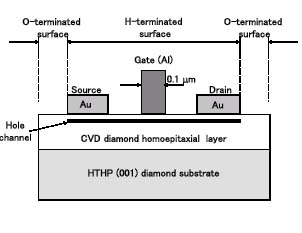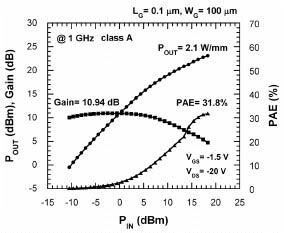Makoto Kasu and Kenji Ueda
Materials Science Laboratory
The data transfer rate in communications is increasing very rapidly. Therefore, electronic devices that can operate in the gigahertz (GHz) range with higher output power are urgently needed. Among semiconductor materials, diamond has the highest thermal conductivity and the highest breakdown electric field. It also offers extremely high carrier mobility and saturation drift velocity. Therefore, diamond electronic devices are expected to exhibit the best performance in high-frequency and high-power operation.
Diamond films formed by the currently available growth techniques contain high-density crystalline defects and impurities, so that it has been very difficult to obtain high-purity diamond. Recently, we have developed technologies for the pre-growth treatment of the substrate surface and for CVD growth using highly pure methane source gas.
Figure 1 shows the diamond field-effect transistor (FET) structure. A
diamond homoepitaxial layer was grown by CVD on high-temperature high-pressure
(HTHP)- synthesized diamond substrate, and then a hole channel was formed
near the surface by hydrogen surface passivation. Finally, using electron-beam
lithography and self-alignment technologies, a submicron-long Al gate was
formed. Recently, by improving these technologies, we were able to reduce
the gap between the source and gate contacts to ~0.5 µm and the gate
length to 0.1 µm, which results in improvement of FET RF characteristics.
Figure 2 shows input-output power characteristics obtained at 1 GHz in
the class-A operation for a diamond FET with gate length (Lg) of 0.1 µm
and gate width (Wg) of 100 µm. The maximum output power density (Pout) was 2.1 W/mm, which is seven times higher than the highest value we reported
previously and two times higher than that of GaAs FETs commonly used in
present systems. The linear power gain of 10.94 dB for a wide input power
range and the power-added efficiency (PAE) of 31.8% are similar to those
of devices in present systems.
We are studying ways to boost the operating frequency and output power and, at the same time, devoting much effort to improving the reliability of diamond FETs.
[1] M. Kasu, K. Ueda, H. Ye, Y. Yamauchi, et al., Electronics Letters 41 (2005) 1249.
[2] M. Kasu, K. Ueda, H. Ye, et al., Diamond and Related Materials 15 (2006) 783.
 |
 |
||||
|
|